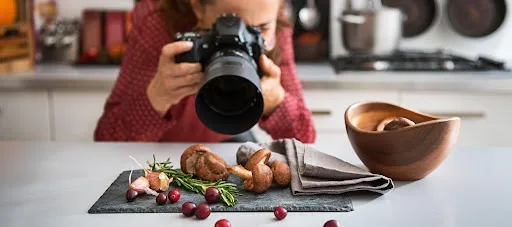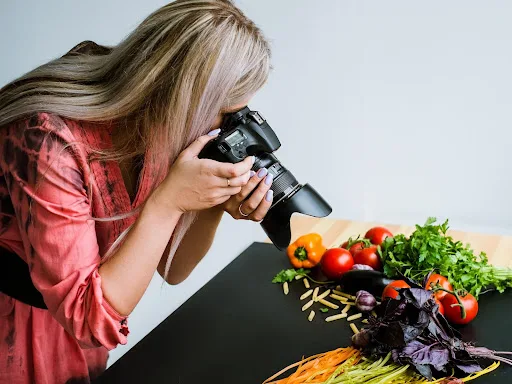Diving into the world of food photography can be as exciting as it is daunting. Capturing the essence and appeal of food through your lens is an art that requires not only creativity but also a good deal of technical know-how. Whether you’re aiming to enhance your personal blog, contribute to food stock images, or simply want to celebrate your culinary achievements on social media, mastering the basics can radically transform your photos from good to absolutely mouthwatering. In this beginner’s guide, we’ll cover essential tips and tricks, along with key dos and don’ts, to help you get started on your food photography journey. So, grab your camera, and let’s make your dishes look as delicious as they taste!
Essential Dos for Food Photography Beginners
Use natural lighting
Natural lighting is your best friend when it comes to food photography. The soft, diffused light of a cloudy day can make the colors of your dish pop and give it a more appetizing look. Try to set up your shoot near a window where plenty of natural light comes in. However, avoid direct sunlight as it can create harsh shadows and highlights that distract from the food itself. If the light is too strong, use a sheer curtain or a diffuser to soften it. Remember, the goal is to make the food look as delicious and inviting as possible.
Style the food appropriately
Styling is almost as important as the photography itself. You want your dish to look its best, so take the time to arrange it in an appealing way. Use fresh ingredients for garnishes, and don’t be afraid to tweak things a bit to make them look perfect. Consider the plates and utensils as well; sometimes, a simple background can make the food stand out more. Also, experiment with different angles and compositions to find what highlights the best features of the dish. A little effort in styling can go a long way in making your food photographs look professional.
Common Don’ts for Food Photography Beginners
Avoid using direct flash
One of the biggest mistakes beginners make is using the direct flash on their camera. This can create unflattering shadows and highlights, and often makes the food look flat and unappetizing. Instead, rely on natural light as much as possible. If you’re shooting in a situation where additional light is needed, consider using a reflector to bounce the natural light onto your subject or invest in some soft, artificial lights designed for photography. Always aim for the most natural look possible to make your dishes look mouth-watering.
Don’t overcrowd the frame with props
While props can add interest to your food photos, it’s important not to go overboard. Overcrowding the frame with too many props can distract from the main subject: the food. Choose a few carefully selected items that complement the dish and enhance its appearance without taking over the scene. Remember, the focus should always be on making the food look as appealing as possible. If you’re unsure, it’s often better to opt for simplicity and let the dish speak for itself.
Avoid overly editing the photos
In the age of digital photography, it’s tempting to fix everything in post-production. However, overly edited photos can look unnatural and unappetizing. Aim for a more natural editing style that enhances the photo without changing it drastically. Adjust the exposure, contrast, and saturation levels if needed, but try to keep the food looking as close to real life as possible. Authenticity is key in food photography, as you want your audience to crave the dishes you’re capturing.
In conclusion, starting with food photography can be an exciting journey. By following these essential dos and don’ts, beginners can significantly improve their skills and start capturing delicious dishes that appeal to viewers. Use natural lighting whenever possible, style your food to look its best, avoid the pitfalls of direct flash and overcrowding with props, and keep your editing natural. With practice and attention to these tips and tricks, you’ll be well on your way to taking mouth-watering food photos that could even make a part of fantastic food stock images. Remember, the most important thing is to have fun and enjoy the creative process!
Tips for Capturing Mouthwatering Shots
When it comes to food photography, the devil really is in the details. Capturing those mouthwatering shots that make viewers want to reach through their screens and take a bite involves a keen eye for detail, a bit of creativity, and an understanding of some fundamental techniques.
Focus on the details
The textures, colors, and layers of your dish are what will ultimately make it stand out. Pay close attention to the way the light hits different elements of your dish. Is there a glisten on that freshly sliced tomato? Or the way the sauce perfectly drizzles over the edges of a chocolate cake? These are the details that bring your food photographs to life. Don’t be afraid to zoom in and capture these micro moments. It’s often the smallest details that can make the biggest impact in food photography.
Experiment with different angles
Not every dish will look its best from the same angle. While the classic overhead (or “birds-eye view”) shot is popular and works well to showcase the entirety of a meal, it might not always be the best choice. Some dishes benefit from being shot at a 45-degree angle or even straight on, especially if height or layers are a significant feature (think of a stacked burger or a layered cake). Experimenting with different angles can help you capture the dish in its best light, emphasizing its most appealing qualities.
Utilize negative space effectively
While your focus is on the food, don’t underestimate the power of the space around it. Negative space, when used effectively, can help your subject stand out even more. It creates a visual breathing room around your dish, focusing the viewer’s attention exactly where you want it. Be mindful of the background and surfaces you are using. Sometimes, a simple, uncluttered background can make your food the star of the show, allowing its colors and textures to really pop.
Tricks for Enhancing Your Food Photography Skills
Beyond just capturing a good shot, there are several tricks you can employ to really elevate your food photography skills. With the right tools and techniques, you can turn a good photo into a great one.
Invest in a good camera
While smartphones continue to improve in terms of camera quality, investing in a good DSLR or mirrorless camera can really make a difference in your food photography. These cameras offer greater control over aspects like aperture, shutter speed, and ISO, allowing you to fine-tune the look of your photos. Plus, the ability to change lenses means you can choose the best lens for the specific type of food photography you’re doing, whether you need a macro lens for close-up details or a wide-angle lens for tablescapes.
Practice composition techniques
Understanding and applying composition techniques can dramatically improve the visual appeal of your food photography. Elements like the rule of thirds, leading lines, and framing can guide viewers through your photo, making it more engaging. Try to arrange your food and props in a way that feels balanced and aesthetically pleasing, creating a composition that tells a story or evokes a mood. Composition is an art in itself, so practice is key.
Utilize editing software wisely
Post-processing is a crucial step in food photography, but it’s important to use editing software wisely. Programs like Adobe Photoshop and Lightroom can enhance your photos, adjusting exposure, contrast, and saturation to make the colors of your dish pop or to correct any lighting issues. However, it’s important to keep edits realistic to ensure the food still looks appetizing and true to life. Overediting can make food look artificial and unappealing, so aim for a light touch, enhancing rather than transforming your images.
By focusing on these tips and tricks, beginners can start to capture food photographs that not only look delicious but tell a story. With practice, patience, and a bit of creativity, anyone can develop their skill in food photography, creating stunning images that showcase the beauty and artistry of culinary creations.
Conclusion
Diving into the world of food photography can be as delicious as it is challenging. Embrace these tips and tricks, and remember, practice is key. Start with what you have, experiment with lighting, angles, and composition, and don’t be afraid to eat your subjects once you’re done shooting! Food photography not only celebrates the art of cooking but also hones your skills behind the lens. Keep snapping, and soon, you’ll be capturing drool-worthy food stock images like a pro.







